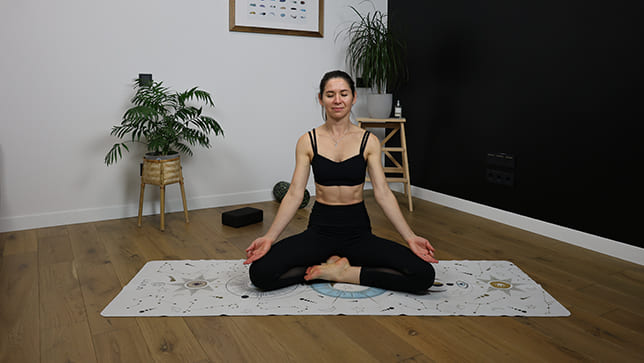Half Perfect Pose - Ardha Siddhasana

Contents
Half Perfect Pose also known Ardha Siddhasana is an easier variation of the traditional Siddhasana. Ardha Siddhasana benefits people who suffer from a limited range of motion or whose hip joints are not open properly. Just like the traditional Siddhasana pose, Ardha Siddhasana Isha yoga has its significance. It is considered as a means to raise your consciousness and foster harmony with the universe.
Ardha Siddhasana helps to stretch the hips and thighs, as well as improve posture and calm the mind. It also helps to activate the root chakra, which is associated with stability and grounding.
In addition to its physical benefits, Ardha Siddhasana can also help to improve concentration and focus. The pose can be held for several minutes at a time, making it a great preparatory posture for longer periods of seated meditation.
Pose Detail
- Difficulty: Beginners
- By Type: Flexibility Yoga Poses, Hip Opening Yoga Poses, Meditation Yoga Poses, Restorative Yoga Poses
- Body Position: Seated Yoga Poses
- By Benefit: Yoga Poses For Stress Relief
Step-by-Step Instructions
Benefits and Contraindications
Activates the root chakra
Stretches the hips and thighs
Improves posture by strengthening the muscles in the back and shoulders and promoting spinal alignment
Calms the mind and reduce stress and anxiety
Enhances concentration
Knee or hip injuries
Low blood pressure
Pregnancy
Modifications and Props for Beginners
- If you have tight hips, you can sit on a block or folded blanket to create more space in your hips and help you sit more comfortably.
- If you have difficulty sitting upright, you can place a rolled-up blanket or bolster behind your back for support.
Useful Tips
- Include a thorough warm-up before attempting Ardha Siddhasana. Focus on opening the hips and warming up the spine with gentle twists to prepare the body for the pose.
- Keep your spine long and tall, and gently press your sitting bones down into the ground.
- Activate your core muscles to support the spine. This not only adds stability to the pose but also enhances the benefits for your abdominal region.
- You can place your hands on your knees or in your lap, palms facing up or down.
- Relax your shoulders and allow your chest to open.
- Stay in the pose for a few minutes, focusing on your breath and allowing your mind to quiet.
How to sit in ardha siddhasana for long time?
Sitting comfortably in Ardha Siddhasana requires proper alignment, a supportive surface, and warm-up stretches. Choose a firm and comfortable surface to sit on, such as a yoga mat, cushion, or folded blanket. Before sitting in Ardha Siddhasana, warm up your hips, knees, and ankles with gentle stretches and movements to prepare your body for the pose and reduce the risk of discomfort.
In this pose, bend your right knee, placing it under your left thigh, keeping your left leg extended. Maintain an erect spine and focus on even breathing. You can switch to the opposite leg to balance the effects on both sides of your body. Listen to your body, and if you experience discomfort or pain, release the pose and try again later. Yoga is a personal practice, and consistency and patience are crucial for progress.
Frequently Asked Questions
Yes, Ardha Siddhasana is a beginner-friendly pose that can be modified with props to suit your needs and abilities. It is a great pose to practice regularly as it helps to improve flexibility, balance, and focus.
If you experience pain or discomfort in Ardha Siddhasana, you should come out of the pose and try a modified version with props or seek guidance from a yoga teacher. It is important to listen to your body and not push beyond your limits.
You can hold Ardha Siddhasana for as long as feels comfortable for you, but it is recommended to start with a few breaths and gradually increase the duration as you become more comfortable with the pose. You can practice for a few minutes up to several minutes.
Common mistakes in Ardha Siddhasana include rounding the spine, collapsing the chest, and placing too much weight on one hip. It’s important to keep the spine long and tall, relax the shoulders, and distribute the weight evenly on both sitting bones.